Stack Data Structure
Uploaded by
sudersenStack Data Structure
Uploaded by
sudersenStacks are the data structure that supports LIFO (Last in first out) functionality that is last
inserted element will get popped first. In some cases, when we need to process the data which is
entered last at the beginning, we sue this stack data structure. As the stack data structure uses
LIFO feature, they become the storage structure for recursion functions. They are used in UNDO
and REDO functions in Editor as we need to UNDO last operation we have done. For instance,
Microsoft word, Adobe photoshop applications has the UNDO and REDO feature which is based
on LIFO. They are also used in Operating system functions in trace backing of operations.
The main functions used in stack are:
push - pushes the data into the stack
pop - removes the last element / topmost element out of the stack
isEmpty - check if the index of the stack empty or not
peek - getting the last element inserted / topmost element without deleting
the element
Diagram 1.1 and 1.2 represents an example of Stack data structure which uses the LIFO
functionality.
Diagram 1.1 Diagram 1.2
Output :
Diagram 1.3
Based on the output from diagram 1.3, three numbers have been pushed into the stack
(50,10,99). Once pop method is used “s.pop( )” the last element inserted is being removed.
Therefore, the remaining element would be 10 and 50. Diagram 1.4 below shows a simple
representation of the code and output based on diagram 1.1 – 1.3.
LAST-IN-FIRST-
PUSH OUT POP
99
10
10
50
50
Diagram 1.4
You might also like
- What Is A Stack?: Some Key Points Related To StackNo ratings yetWhat Is A Stack?: Some Key Points Related To Stack23 pages
- D.Y.Patil Technical Campus, Talsande Faculty of Engineering & Faculty of Management (Polytechnic)No ratings yetD.Y.Patil Technical Campus, Talsande Faculty of Engineering & Faculty of Management (Polytechnic)21 pages
- Abstract Data Types (ADT's) (Stack) - Anqa#11GreenNo ratings yetAbstract Data Types (ADT's) (Stack) - Anqa#11Green9 pages
- Stacks: Uses and Applications of StacksNo ratings yetStacks: Uses and Applications of Stacks10 pages
- Stack (Abstract Data Type) : For The Use of The Term LIFO in Accounting, SeeNo ratings yetStack (Abstract Data Type) : For The Use of The Term LIFO in Accounting, See2 pages
- Unit - 2 Linear Data Structures (Stacks)No ratings yetUnit - 2 Linear Data Structures (Stacks)15 pages
- Introduction-to-Stacks-in-Data-Structures (1)No ratings yetIntroduction-to-Stacks-in-Data-Structures (1)12 pages
- Data Structure (Stack) Notes by Nitin Paliwal100% (1)Data Structure (Stack) Notes by Nitin Paliwal5 pages
- Modeling and Simulation of Logistics Flows 3: Discrete and Continuous Flows in 2D/3DFrom EverandModeling and Simulation of Logistics Flows 3: Discrete and Continuous Flows in 2D/3DNo ratings yet
- Correction Template - Assignment 1 - 2021 NewNo ratings yetCorrection Template - Assignment 1 - 2021 New3 pages
- MCA IV Report Chess Cum Chat ApplicationNo ratings yetMCA IV Report Chess Cum Chat Application83 pages
- Life Cycle Comparison of Traditional Retail and E-Commerce Logistics ForNo ratings yetLife Cycle Comparison of Traditional Retail and E-Commerce Logistics For20 pages














































































